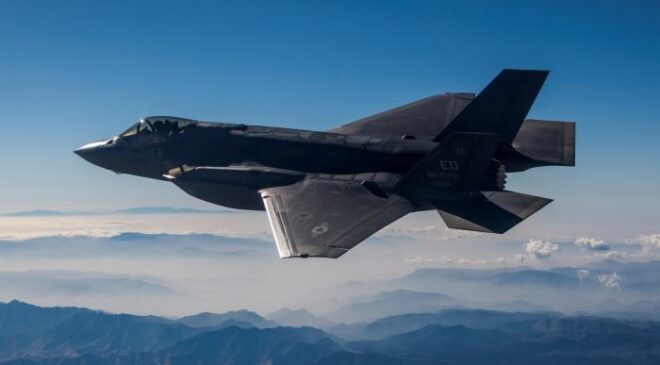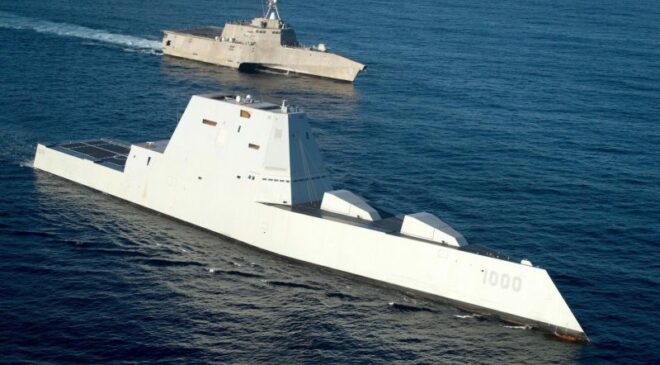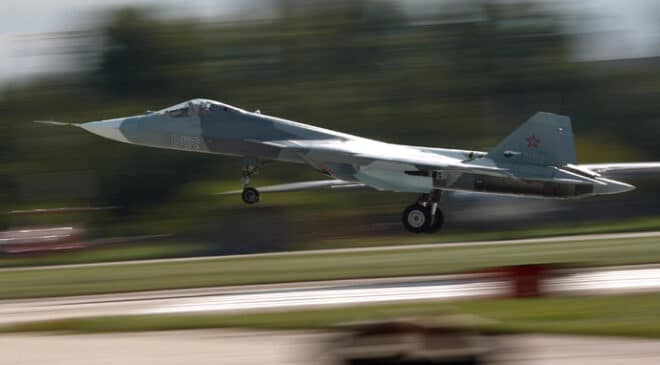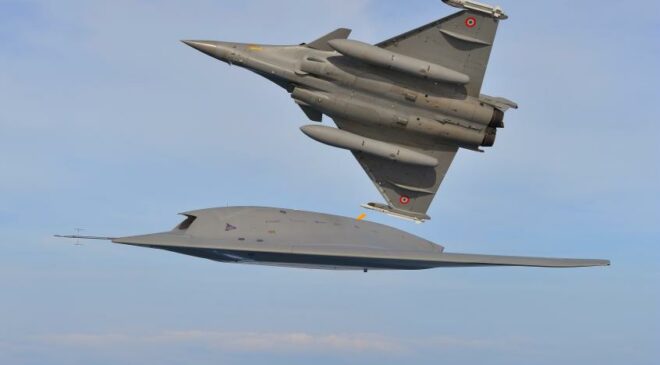In this section:
A few days before the opening of the 2019 Paris Air Show, the FCAS program, which is at the heart of Franco-German ambitions for the next 50 years in terms of military aeronautics, has invested the media, not stingy with superlatives about it.
However, this program does not lack risks, including concerns about long-term Franco-German industrial cooperation, or technological uncertainties, with the Chief of Staff of the Air Force himself admitting that the technological environment in 2045 could not be envisaged today.
In addition, the FCAS, considered as a threat by the US military industry very attached to the protection of its European market, is also a target for external factors, this explaining the US eagerness to lock down its European customers with its F35, whose operational life will exceed 2060.
Beyond these risks, common to the majority of ambitious military programs, the FCAS program, by its nature, and the paradigms underlying the project, also bears much more problematic stigmas, potentially generating significant dangers for the French and European defense industry, as well as the operational capabilities of the armed forces of the participating countries.
1- The danger of the FCAS program for Defense Europe;
The FCAS is today presented as the flagship program for the construction of the Europe of Defense, by bringing together two of the most important aeronautical industries in the Union, and by its ambitions likely to keep Europe technologically at the level of the large military nations.
But this ambition is antithetical to the format chosen for the program, namely a device intended to replace the German and Spanish Typhoons, and the Rafales French.
Indeed, in the European Union, only 6 of the richest countries, out of 28 member countries, have equipped themselves with these two devices, the prices of which for purchase and use put them beyond the reach of many budgets. .
When they can, it is to the detriment of a fleet of significant size, like Belgium forced to bring back its air fleet to 32 aircraft to be able to acquire a replacement for the F16.
In addition, the choice of a single aircraft hinders numerous processes, whether technological or industrial, posing a risk to the entire air fleet of the countries concerned.

2- The danger for maintaining industrial skills
By focusing on a single combat aircraft, supported, it is true, by drones of varying sizes, the FCAS requires a strict division of the industrial capacities of the participating European companies.
To the extent that French, German and Spanish industries have common skills, and the FCAS will cover all the needs of the air forces of these three countries, it seems obvious that certain manufacturers, having developed cutting-edge skills over the years years, will have to lose the benefit of this knowledge, because the equipment will have been entrusted to another country for reasons of industrial sharing.
In other words, the losers from the industrial distribution of the FCAS are likely to disappear from these markets, which represents a form of forced European industrial consolidation that is very ineffective.
Furthermore, this will hamper the capabilities of France, which today is able to design and manufacture a combat aircraft on its own, to consider the design of an aircraft complementary to the FCAS, or to succeed it, independently.
Thus, while the Tornado and Typhoon allowed European industries to increase their skills, the FCAS program risks forcing French industry to abandon skills essential to the design of an aerial system, and therefore not being able, in the future, to consider the design of a new device only in partnership with other European countries.
Under the guise of strategic independence from Washington, the FCAS builds, in its current format, French strategic dependence on its European partners, first and foremost, Germany.
3- Technological danger;
The FCAS program is based on a well-known paradigm in innovation management, consisting of starting from a blank page and the anticipation of future needs, to define a project detached from past constraints, no longer having reasons for being in the future.
This is the very definition of the disruptive program that DARPA or Google regularly practice. However, if the approach has many virtues, it is also, by far, the most risky, because it is conducive to excessive technologism, and an ambition sometimes disconnected from technological and operational realities.
This is the reason why, in the portfolios of institutional technology investors, such as American pension funds, this type of product represents only a small share of investments, acting as a potential, but not necessary, wild card.
It is also remarkable to note that the F35 program was based, and still is based, on these same paradigms, like the Zumwalt destroyer program, or the Comanche helicopter, American programs sharing an important characteristic, the phenomenal drift in costs. focus.
If the US Army and the US Navy were able to put an end to the financial hemorrhage represented by these programs, the US Air Force kept the F35 at arm's length, making it the most expensive in the history of the States -United, for an aircraft which is barely beginning, after more than 400 units built, to carry out operational missions, and whose maintenance costs remain twice as high as expected.

driven by excessive technology
Note also that this paradigm is the exact opposite of the recommendations made by GIFAS in 2016 on the conduct of R&D and French military aeronautical production, which were based on demonstrator cycles intended to develop and make reliable the technologies that would have subsequently been integrated in the form of elementary bricks in the construction of prototypes and series devices.
4- The economic danger
Beyond the political and European aspects, which we have seen are not optimal, the FCAS program was justified by the French and German authorities by the impossibility for European countries to develop on their own an air combat system of the future, as much technologically and budgetarily.
These two postulates are very questionable, as France is largely able to carry out the technological program autonomously, and the study of the budgetary returns of the Defense investment in La Défense à Valorisation Positive undermines the second.
But it is above all through its planning that the FCAS threatens the French national economy. Indeed, the Defense Industry has a determining economic role for the country, with 200.000 direct jobs representing 13% of national industrial production, and average exports reaching €10 billion each year, essential for balancing the trade balance. from the country.
However, exports from Rafale, the only aircraft available for sale between today and 2040, will undoubtedly become more difficult after 2030, when almost all of the aircraft intended for the French forces will have been delivered.
From then on, the French military aeronautics industry, bringing together more than 500 companies, will only have an industrial production perspective of a few dozen Rafale over the period between 2030 and 2040, while maintaining a production line requires the annual production of 11 devices, posing serious threats to the maintenance of industrial skills and employment, as well as to related social and tax revenues. maintaining defense exports.
On the other hand, France, and Europe, will be absent from international competitions to replace combat aircraft between 2030 and 2040/45, because neither Rafale nor the Typhoon, even modernized, will be able to prevail against the American F35, the Russian Su-57 or the Chinese FC31, not to mention the Korean, Turkish or Japanese "5th generation" aircraft programs, which could well make the market even more difficult than it is today.

very competitive, with the Russian Air Force buying it for €32 million each.
5- The danger for the Defense of Europe;
If the FCAS poses significant threats to European industry and the economy, they represent very little compared to the danger it poses to French and European defense capabilities.
Indeed, despite the current modernization programs, for the Rafale such as Typhoon, these devices will no longer be able to meet the operational requirements of high-intensity theaters from 2025/2030 in their current format. Indeed, in the absence of specialized versions for electronic warfare, French and German aircraft will be very exposed to modern anti-aircraft defenses such as the S400 or the Russian S500.
The same goes for the cancellation of the Franco-British FCAS stealth combat drone program, which was to begin its operational career in 2030, and which was to support the Rafale et Typhoon in their missions of eliminating defenses in contested environments.
There is little more left for European planes than the performance of the METEOR missile and the future cruise missile to be able to hope to deliver blows against a technological adversary or on an effectively defended territory.
However, like all Western forces, both French and German forces are fully dependent on the support capabilities of their air forces, due to the particularly marked numerical weakness of their land forces. By neutralizing this air power, all European continental defensive capabilities will therefore be very exposed, due to FCAS planning.
Conclusion
We see that, despite the enthusiasm it arouses, the FCAS program is not free of defects which can generate major risks for the economy, technological independence and security of the countries participating in it as well as the European continent.
These risks and dangers are not prohibitive, and solutions exist that would allow the program to integrate into a safer and more open approach, in all areas.
Moreover, it is not the existence of these corollary threats but the absence of their taking into account which today raises a question, and calls into question the objectives sought by the protagonists of the program...

version dedicated to electronic warfare of the Rafale/Typhoon and a UCAV derived from the Neuron
Indeed, among the possible and applicable solutions, it would be possible to quickly develop a version dedicated to electronic warfare of the Rafale and Typhoon, as well as resuming the FCAS program based on the Neuron, with a rapid timetable, so as to have a triptych of combat aircraft / electronic warfare and UCAV at the operational and commercial level before 2030.
In addition, it would be profitable to divide the program in two, with a single-engine aircraft at a unit price accessible to “small European countries” by 2030, intended to replace the F16, Mirage 2000 and possibly Mig-29 type aircraft. , and a heavier device, on the horizon, to replace Rafale et Typhoon.
This approach would also make it possible to open the program more widely to European partners, while maintaining the skills of all European BITD stakeholders.
It would be regrettable if the FCAS program, which aims to be an example of European innovation, ends up becoming a nemesis, as was the case, in its time, with the mirage IIIV Gerfaut, victim of excessive ideologism and a lack of of discernment in the conduct of the program.

